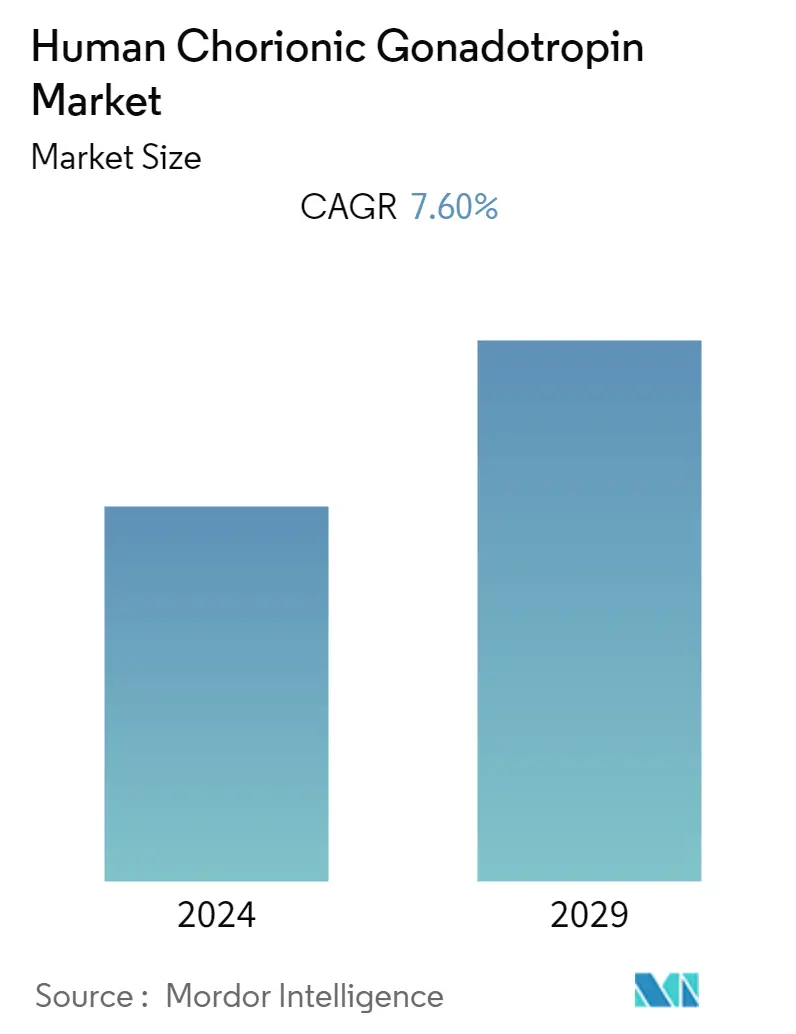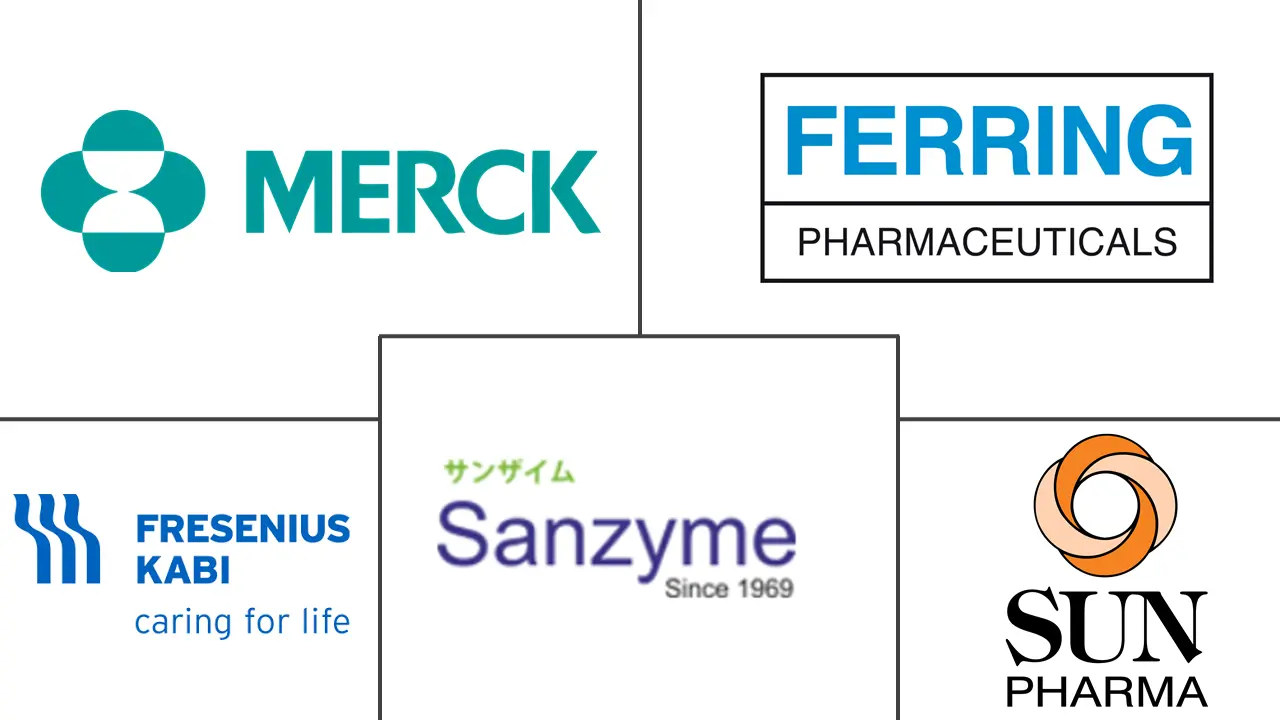Market Size of Human Chorionic Gonadotropin Industry

| Study Period | 2021 - 2029 |
| Base Year For Estimation | 2023 |
| CAGR | 7.60 % |
| Fastest Growing Market | Asia-Pacific |
| Largest Market | North America |
| Market Concentration | Medium |
Major Players
*Disclaimer: Major Players sorted in no particular order |
Human Chorionic Gonadotropin Market Analysis
Over the next few years, the human chorionic gonadotropin market is expected to register a CAGR of about 7.6%.
Due to COVID-19 restrictions worldwide, foot traffic in hospitals and clinics decreased significantly, negatively impacting the growth of the human chorionic gonadotropin market. For instance, according to the research study published by Frontiers Media S.A. in April 2022, many infertile patients decided not to request assisted reproductive technology (ART) treatments due to the pandemic. During the pandemic, there was a decline in the number of concluded ART cycles as compared to the preceding year (749 vs. 844 cycles). This decline, despite the unchanged availability of ART services, is attributed to many factors: the local restrictions and the fear of SARS-Cov-2 infection and potential adverse obstetric outcomes did not encourage physicians and patients to engage in ART. Although, with the ongoing vaccinations and decreasing cases of COVID-19, the market is expected to regain normalcy over the coming years.
The growth of the human chorionic gonadotropin (HCG) market is attributed to the increasing prevalence of infertility and hypogonadism, changing lifestyles, and increased awareness regarding infertility treatment. Hypogonadism, for example, is characterized by low serum testosterone concentration, which is followed by a number of clinical features such as erectile dysfunction (ED), poor morning erections, low libido, memory loss, physical decline in strength and health, difficulty concentrating, and depression.According to the study published by BMC Endocrine Disorders in July 2021, erectile dysfunction was found to be prevalent in 72.2% of people globally in 2021. Furthermore, according to the CDC update in March 2022, about 1 in 5 (22%) couples in which the woman is 30-39 have problems conceiving their first child, compared to about 1 in 8 (13%) couples in which the woman is younger than 30. Age-related fertility loss is mostly caused by deteriorating egg quality. Older women also have fewer remaining eggs and are more likely to have health issues that can affect fertility. Aging also increases a woman's chances of miscarriage and of having a child with a genetic abnormality. Therefore, the high burden of infertility is also raising the demand for effective treatments such as human chorionic gonadotropin (HCG) hormones, which is fueling the market's growth.
In addition, increasing awareness about HCG among healthcare professionals and patients, coupled with the new product launches, is anticipated to boost the market's growth over the forecast period. Human chorionic gonadotropin is used as a marker in cancer, including choriocarcinoma, seminoma, and germ cell tumors, which may augment the market's growth over the coming years with the increasing cases of cancer. For example, as per the article published in January 2020 by David G. Grenache, HCG was initially developed as a test for pregnancy. But HCG is now commonly used to test women who might have an ectopic pregnancy, along with other biomarkers, to look for fetal aneuploidies and as a tumor marker for a wide range of neoplasms.
Therefore, the factors mentioned above are attributed collectively to the studied market's growth over the forecast period. However, the availability of substitutes is expected to hinder market growth over the forecast period.
Human Chorionic Gonadotropin Industry Segmentation
As per the scope of the report, the human chorionic gonadotropin hormone is a placental hormone secreted by syncytiotrophoblast cells during pregnancy. These hormones stimulate the corpus luteum to produce progesterone. The naturally extracted or recombinant human chorionic gonadotropin hormones are used in the treatment of infertility, male hypogonadism, and many other conditions. The human chorionic gonadotropin market is segmented by product (naturally extracted and recombinant), application (male hypogonadism, female infertility treatment, oligospermia treatment, and other applications), and geography (North America, Europe, Asia-Pacific, the Middle East and Africa, and South America). The market report also covers the estimated market sizes and trends for 17 different countries across major regions globally. The report offers the value (in USD million) for the above segments.
| By Product | |
| Natural Extracted | |
| Recombinant |
| By Applications | |
| Male Hypogonadism | |
| Female Infertility Treatment | |
| Oligospermic Treatment | |
| Other Applications |
| By Geography | ||||||||
| ||||||||
| ||||||||
| ||||||||
| ||||||||
|
Human Chorionic Gonadotropin Market Size Summary
The human chorionic gonadotropin (HCG) market is poised for significant growth over the forecast period, driven by increasing infertility rates and hypogonadism prevalence, alongside heightened awareness of infertility treatments. The market experienced a temporary setback due to COVID-19, which led to reduced foot traffic in healthcare facilities and a decline in assisted reproductive technology (ART) cycles. However, as vaccination rates rise and COVID-19 cases decrease, the market is expected to recover. The demand for HCG is further bolstered by its role in treating infertility and its application in cancer diagnostics, such as choriocarcinoma and seminoma. The growing burden of infertility, particularly among older women, is a key factor propelling the market, as is the increasing awareness and availability of HCG products.
North America is anticipated to witness substantial market growth, supported by a robust healthcare infrastructure and favorable reimbursement policies. The prevalence of infertility in the region, as highlighted by data from the CDC and WHO, is expected to drive the demand for HCG treatments. The market is characterized by moderate competition, with both global and regional players like Merck KGaA, Fresenius SE & Co. KGaA, and Sanzyme holding significant shares. Recent developments, such as InsurMedix's funding for fertility treatment coverage and Inception Fertility's launch of a cryopreservation solution, are likely to further stimulate market growth. The introduction of recombinant HCG products and naturally extracted hormone products is also contributing to the market's expansion, offering personalized therapy options and catering to the increasing demand for effective infertility treatments.
Human Chorionic Gonadotropin Market Size - Table of Contents
-
1. MARKET DYNAMICS
-
1.1 Market Overview
-
1.2 Market Drivers
-
1.2.1 The Increasing Prevalence of Infertility and Hypogonadism
-
1.2.2 Changing Lifestyle and Awareness Regarding the Treatment of Infertility
-
-
1.3 Market Restraints
-
1.3.1 Availability of Substitutes
-
-
1.4 Porter's Five Forces Analysis
-
1.4.1 Threat of New Entrants
-
1.4.2 Bargaining Power of Buyers/Consumers
-
1.4.3 Bargaining Power of Suppliers
-
1.4.4 Threat of Substitute Products
-
1.4.5 Intensity of Competitive Rivalry
-
-
-
2. MARKET SEGMENTATION (Market Size by Value - USD million)
-
2.1 By Product
-
2.1.1 Natural Extracted
-
2.1.2 Recombinant
-
-
2.2 By Applications
-
2.2.1 Male Hypogonadism
-
2.2.2 Female Infertility Treatment
-
2.2.3 Oligospermic Treatment
-
2.2.4 Other Applications
-
-
2.3 By Geography
-
2.3.1 North America
-
2.3.1.1 United States
-
2.3.1.2 Canada
-
2.3.1.3 Mexico
-
-
2.3.2 Europe
-
2.3.2.1 Germany
-
2.3.2.2 United Kingdom
-
2.3.2.3 France
-
2.3.2.4 Italy
-
2.3.2.5 Spain
-
2.3.2.6 Rest of Europe
-
-
2.3.3 Asia-Pacific
-
2.3.3.1 China
-
2.3.3.2 Japan
-
2.3.3.3 India
-
2.3.3.4 Australia
-
2.3.3.5 South Korea
-
2.3.3.6 Rest of Asia-Pacific
-
-
2.3.4 Middle-East and Africa
-
2.3.4.1 GCC
-
2.3.4.2 South Africa
-
2.3.4.3 Rest of Middle-East and Africa
-
-
2.3.5 South America
-
2.3.5.1 Brazil
-
2.3.5.2 Argentina
-
2.3.5.3 Rest of South America
-
-
-
Human Chorionic Gonadotropin Market Size FAQs
What is the current Human Chorionic Gonadotropin Market size?
The Human Chorionic Gonadotropin Market is projected to register a CAGR of 7.60% during the forecast period (2024-2029)
Who are the key players in Human Chorionic Gonadotropin Market?
Sanzyme, Merck & Co. Inc., Ferring BV, Fresenius Kabi AG and Sun Pharmaceutical Industries Ltd are the major companies operating in the Human Chorionic Gonadotropin Market.

